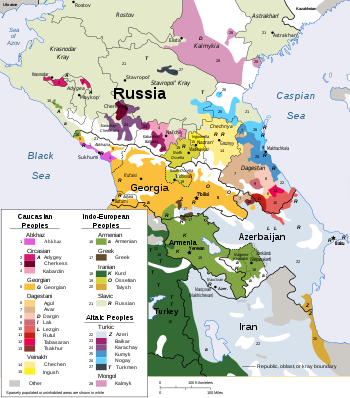Tsezic languages
The Tsezic languages (also called Didoic languages) form one of the seven main branches of Northeast Caucasian language family. It branches into Tsez–Hinukh and Bezhta–Hunzib–Khwarshi, according to the latest research.[2] They were formerly classified geographically into East Tsezic (Hinukh, and Bezhta) and West Tsezic (Tsez, Khwarshi, and Hunzib). The Avar language serves as the literary language for speakers of Tsezic languages.
| Tsezic | |
|---|---|
| Geographic distribution | Southwest Dagestan |
| Linguistic classification | Northeast Caucasian
|
| Glottolog | tsez1239[1] |
 Tsezic | |
Internal branching
Schulze (2009)[2] gives the following family tree for the Tsezic languages:
- Tsez–Hinukh
- Tsez (15,400)
- Hinukh (550)
- Bezhta–Hunzib–Khwarshi
Figures retrieved from Ethnologue.[3]
gollark: You should convert old motherboards into tasteful decorative items.
gollark: You can make that old motherboard into, say, a coaster for drinks.
gollark: *oops*
gollark: Anyway, reboot it.
gollark: BEES!
References
- Hammarström, Harald; Forkel, Robert; Haspelmath, Martin, eds. (2017). "Tsezic". Glottolog 3.0. Jena, Germany: Max Planck Institute for the Science of Human History.
- The Languages of the Caucasus, by Wolfgang Schulze (2009) Archived 2017-09-18 at the Wayback Machine
- Ethnologue
This article is issued from Wikipedia. The text is licensed under Creative Commons - Attribution - Sharealike. Additional terms may apply for the media files.
